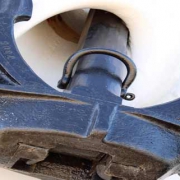The Ethane conundrum
Some time ago, I have written about the LPG tidal wave that hits us mostly from the US and how it shakes the world in its foundations. LPG (Propane and Butane in whatever mixing proportion you happen to like it) are already a pretty exotic market when compared to crude and other refined produces. Most of the developed world has moved on to either natural gas or other forms of energy in order to get what one can get from LPG too.
But there is more fringy even – enter the world of Ethane.
Ethane is a petroleum gas that will readily condense into a liquid if some pressure is applied to it. It is also much easier to liquefy than Methane as much higher temperatures will suffice. And, at the top of the Natural Gas Liquids chain with its two carbon atoms and the 6 hydrogen, it’s a pretty darn clean hydrocarbon as well.
It looks and feels much like its brethren Propane and Butane as its also very similar to them when it comes to its physical and thermodynamic properties. However, it also is a real fringe product that had little value outside the petrochemical world where it is a much-appreciated feed stock for ethylene production.
Using it for power production was a no-no so far as volumes were not sufficient to warrant the effort of cranking up application development and a specific supply chain.
That’s starting to change as the fracking revolution has made copious amounts of ethane available – so much in fact that the price for the ton of the product has crashed on the world market. Most of the new ethane produced hails from the US where it is a byproduct of shale oil and gas production. US infrastructure was not built in order to deal with those enormous volumes of ethane and it will take some time to adjust that by building new facilities. In the meantime, the pressure in the Gulf of Mexico stays on.
In principle, Ethane can be used for power production just like any other Natural Gas Liquid. Only the limited amount available – so far – did not justify the cost of building up supply chains and market applications. This begins to change as the pressures in North America push local power producers to try using Ethane as super clean feed stock for their Combined Cycle Gas Turbines.
A trial West Virgina tries just to do that. A local generator, Moundsville Power, plans to build a power plant using GE CCGT that runs on a blend of Natural Gas and Ethane. The reasons are simple – infrastructure to ease the Ethane glut in the US is still insufficient which means that in pockets in the Marcellus shale the Ethane glut is so severe that some producers must absolutely get rid of it in order to preserve cash flow from Natural Gas and the heavier hydrocarbons. In this sense, Ethane is a trashy product that produces more hassle that good. Considering how clean a fuel Ethane is, this is a hard one to swallow for an environmentally minded energy man.
Export infrastructure as well as specific Ethane tankers are under construction now and are bound to enter service soon. The first ethane export from the US has gone to Norway and unsurprisingly serves as feed stock for the Petrochemical industry.
But there is no reason why exported Ethane could not be used for power production. Why would anyone want to do that?
Two reasons:
Firstly, Ethane is cheap, real cheap. On a USD/MMBtu FOB USGC basis, Ethane is almost exactly half as expensive as Propane and more than half as expensive as Butane. It’s also only half as expensive as the really very dirty HFO and less than a third of the cost of MGO. This is strong stuff even in a lower price world we are in now as it can be expected that shale gas will expand even further reinforcing the glut.
Secondly, GM claims that CCGT’s can run just as well under pure Ethane as they do under Methane. I imagine that some retooling would be required but my non-engineers mind expects that this will be limited in scope.
Why is that important? Let’s come back to one of my favorite patches of the energy world – Africa.
I have written extensively on the South African energy conundrum and its nasty consequences and how LNG would help the country mightily. The blow back is that except FSRU’s, there is no quick road to LNG imports as terminals will have to be developed and the paltry local market also needs to develop absorption capacity as crazy as this sounds in an energy starved country such as South Africa.
This means that any energy import venture would have to go hand in hand with some form of IPP scheme in order to have off take secured immediately. It just so happens that South Africa is one of the hardest business environments with its stifling business attitude and its copious political overgrowth of regulation and affirmative action programs as well as suffocating red tape and bureaucracy.
Starting things off with some Ethane importing scheme plus CCGT and converting to Methane later on the same hardware when LNG finally works out might be a sensible path to go. And who knows, this might be a model for many African countries that want to join the Natural Gas bandwagon but for one reason or another, cannot do it out of the box.
But in the meantime, there is closer fish to fry for wannabe US exporters – the Caribbean with its myriad islands. LNG would do those islands good but developing the kind of infrastructure that would allow even the tiniest speck of inhabited land to be served with LNG will take a little while.
Ethane from the US might be a good idea as it’s quicker to develop and distances from the source are short.
Eventually, it will be Natural Gas and its cool brother LNG that will take the throne but in some fringe markets, Ethane might wanna make the first push away from HFO and diesel towards a gassier energy paradigm.














The raw gas coming out of the ‘wet’ Marcellus is very high in ethane. Problem is, the crackers installed to produce plastics require purity grade ethane, Rather than spend $ separating the ethane for resale, a CCGT was designed to use the product in its raw form. This is a by-product created by lack of separating capacity. We’ll see how it works… Good article Herr Huber….
The situation intrigued me. The US will retool their crackers but in the meantime and with all the overcapacity on the LNG shipping side how about taking an old lady MOSS LNG tanker, filling it up with trash ethane and getting it to Africa to run some powergen. Maybe there is a rotten tomato somewhere in my reasoning but now it’s in the open and experts better than I am can flush it out. Thanks for taking the time to comment.